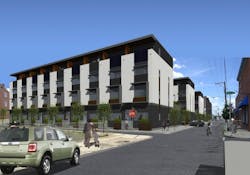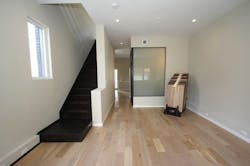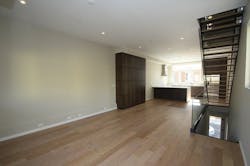First Passive House-certified homes primed in Philadelphia
The first group of Passive House-certified homes called the Stables will be ready for occupancy in spring of 2013. The row of Passive House single-family townhomes is being developed by Onion Flats group, award-winning sustainable architects, developers, and builders in a joint venture partnership with Domani Developers.
The purpose of this project was to provide people with high-quality sustainable design and homes consuming up to 90 percent less energy. The project will also be Net Zero Energy and will take advantages of solar technologies to supplement its already low energy demands. “We like to think this way because most developers don’t,” said Timothy McDonald, a principal at Onion Flats, in a release. “For us, it’s not something new.”
Designed on the prevalent Philadelphia row house typology, the project begins with one of the most efficient urban forms of dwelling, which also makes it an ideal model for modular manufacturing. The first three structures above the foundations were built in a modular factory while the foundations were constructed on site. This fast track process reduced construction time by 50 percent.
The homes themselves are built to Passive House standards. The super energy efficiency will reached by combining many factors together which will lead to super air tight and efficient envelopes.
Special attention was paid to creating a building that uses a minimum of resources, generating its own power from a 4.23 kilowatt solar array, and includes a 95 percent permeable site including green roofs and porous paving for managing stormwater. Super insulated walls (R-34) and roof (R-52) combined with triple pane super-efficient Intus Windows and doors (R-8) play huge role while pursuing for Passive house standards. “Sustainability is what we are working on and well known for,” said McDonald. “It’s time to take it to the next level.”
House energy monitoring system installation in every house will help homeowners to be a part of the ongoing process and follow energy consumption in their home. Super-insulated exterior envelopes will significantly reduce the need for heating and cooling and thus decrease the overall operating costs. Combining all those factors together the project will reach its goal and reduce its environmental impact almost to zero.
“The houses are going to be completely energy sufficient by themselves, occupants will be responsible for energy use–what’s called net-zero energy possible,” said McDonald.
Completion nears for the first three homes in the 27-unit Stables townhomes project. The primary project was significantly downsized from 70 to 27 units from the original plans.
“The money issue for larger residential projects still remains relevant,” said McDonald. ”It’s been taking us to go to many different banks and every time to come up with something that would make it work, but it won’t stop us” he said. According to McDonald, the first unit should be completed by May.
For more information, visit the Stables property listing at the McDonald Group.





